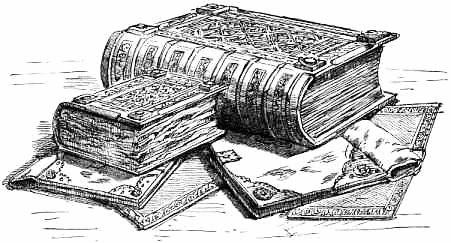Classes as Archetypes
I'm not personally a fan of classes, as I find them confining, and I certainly wouldn't want to add classes to Savage Worlds. However I find archetypes an excellent compromise - they provide a quick and easy way to create new characters that fit the setting, without limiting players who want to build less orthodox characters.
D&D settings are obviously designed with the D&D game system in mind, which means they usually include the same selection of common classes. When converting such settings to Savage Worlds, it can therefore be beneficial to offer archetypes that reflect the base classes:
Barbarian
Attributes: Agility d6, Smarts d4, Spirit d4, Strength d8, Vigor d8
Skills: Climbing d4, Evading d6, Fighting d6, Healing d4, Intimidation d4, Notice d4, Riding d4, Shooting d4, Survival d4, Swimming d4, Throwing d6, Tracking d4
Charisma: –; Pace: 8; Parry: 6 (1); Toughness: 7 (1)
Hindrances: One Major, Illiterate, one additional Minor
Edges: Berserk, Fleet-Footed
Gear: Battle axe (Str+d8), target shield (+1 Parry), throwing axe (Str+d6; range 3/6/12), thick furs (+1)
Bard
Attributes: Agility d6, Smarts d6, Spirit d8, Strength d6, Vigor d4
Skills: Climbing d4, Evading d4, Fighting d4, Knowledge (Bardic Lore) d6, Lockpicking d4, Notice d4, Persuasion d6, Riding d4, Shooting d4, Spellsinging d6, Stealth d4, Streetwise d4
Charisma: +2; Pace: 6; Parry: 6 (2); Toughness: 5 (1)
Hindrances: One Major, two Minor
Edges: Charismatic, Novice Spellsinger
Gear: Rapier (Str+d4; +1 Parry), buckler (+1 Parry), bow (2d6; range 12/24/48), padded vest (+1)
Cleric
Attributes: Agility d4, Smarts d6, Spirit d8, Strength d6, Vigor d6
Skills: Evading d4, Faith d8, Fighting d4, Healing d6, Knowledge (Planes) d4, Knowledge (Religion) d6, Notice d4, Persuasion d6, Riding d4, Throwing d4
Charisma: –; Pace: 6; Parry: 5 (1); Toughness: 7 (2)
Hindrances: One Major, two Minor
Edges: Novice Cleric, Turn Undead
Gear: Warhammer (Str+d6), target shield (+1 Parry), sling, chainmail vest (+2)
Druid
Attributes: Agility d6, Smarts d6, Spirit d8, Strength d4, Vigor d6
Skills: Druidry d8, Evading d4, Fighting d4, Healing d4, Knowledge (Nature) d6, Notice d4, Riding d4, Survival d6, Swimming d4, Throwing d4, Tracking d4
Charisma: –; Pace: 6; Parry: 5 (1); Toughness: 6 (1)
Hindrances: One Major, two Minor
Edges: Beast Master, Novice Druid
Gear: Staff (Str+d4; +1 Parry), sling, hide shirt (+1)
Fighter
Attributes: Agility d8, Smarts d4, Spirit d6, Strength d8, Vigor d6
Skills: Climbing d4, Evading d8, Fighting d8, Intimidation d4, Knowledge (Battle) d4, Notice d4, Riding d4, Shooting d8, Throwing d4
Charisma: –; Pace: 6; Parry: 7 (1); Toughness: 9 (3)
Hindrances: One Major, two Minor
Edges: Brawny
Gear: Longsword (Str+d8), target shield (+1 Parry), dagger (Str+d4; range 3/6/12), bow (2d6; range 12/24/48), breastplate (+3)
Monk
Attributes: Agility d8, Smarts d6, Spirit d6, Strength d6, Vigor d6
Skills: Climbing d6, Evading d8, Fighting d8, Healing d6, Knowledge (Religion) d6, Notice d6, Stealth d4
Charisma: –; Pace: 6; Parry: 6; Toughness: 5
Hindrances: One Major, two Minor
Edges: Martial Artist
Gear: Robes
Paladin
Attributes: Agility d8, Smarts d4, Spirit d8, Strength d6, Vigor d6
Skills: Evading d8, Fighting d8, Intimidation d6, Knowledge (Religion) d4, Notice d4, Persuasion d4, Riding d6, Shooting d6
Charisma: –; Pace: 6; Parry: 7 (1); Toughness: 7 (2)
Hindrances: One Major, two Minor
Edges: Paladin
Gear: Shortsword (Str+d6), target shield (+1 Parry), chainmail vest (+2)
Ranger
Attributes: Agility d6, Smarts d8, Spirit d6, Strength d6, Vigor d4
Skills: Evading d6, Fighting d6, Healing d4, Notice d4, Shooting d6, Stealth d4, Survival d8, Tracking d8
Charisma: –; Pace: 6; Parry: 6 (1); Toughness: 5 (1)
Hindrances: One Major, two Minor
Edges: Woodsman, Ranger Fighting Style
Gear: Shortsword (Str+d6), main gauche* (Str+d4; +1 Parry), bow (2d6; range 12/24/48), leather jerkin (+1)
Rogue
Attributes: Agility d8, Smarts d6, Spirit d6, Strength d6, Vigor d4
Skills: Climbing d6, Evading d8, Fighting d6, Lockpicking d6, Notice d4, Repair d4, Stealth d8, Streetwise d4
Charisma: –; Pace: 6; Parry: 7 (1); Toughness: 5 (1)
Hindrances: One Major, two Minor
Edges: Thief, Sneak Attack
Gear: Shortsword (Str+d6), main gauche* (Str+d4; +1 Parry), dagger (Str+d4; range 3/6/12), padded vest (+1)
Sorcerer
Attributes: Agility d6, Smarts d6, Spirit d8, Strength d6, Vigor d4
Skills: Evading d4, Fighting d4, Intimidation d8, Notice d4, Persuasion d8, Sorcery d8, Streetwise d6, Throwing d4
Charisma: –; Pace: 6; Parry: 5 (1); Toughness: 4
Hindrances: One Major, two Minor
Edges: Familiar Bond, Novice Sorcerer
Gear: Spear (Str+d6; +1 Parry)
Wizard
Attributes: Agility d6, Smarts d10, Spirit d6, Strength d4, Vigor d4
Skills: Evading d4, Fighting d4, Investigation d6, Knowledge (Arcana) d8, Notice d6, Persuasion d4, Throwing d4, Wizardry d10
Charisma: –; Pace: 6; Parry: 5 (1); Toughness: 4
Hindrances: One Major, two Minor
Edges: Familiar Bond, Novice Wizard
Gear: Staff (Str+d4; +1 Parry)
 I've produced a lot of fan supplements over the last few years, but I've never released any adventures, so I thought I'd try my hand at writing a One Sheet for the Christmas season. For those not familiar with them, One Sheets are bare bones adventures, typically around 1000-1500 words, that are printed on both sides of a single sheet of paper.
I've produced a lot of fan supplements over the last few years, but I've never released any adventures, so I thought I'd try my hand at writing a One Sheet for the Christmas season. For those not familiar with them, One Sheets are bare bones adventures, typically around 1000-1500 words, that are printed on both sides of a single sheet of paper.















